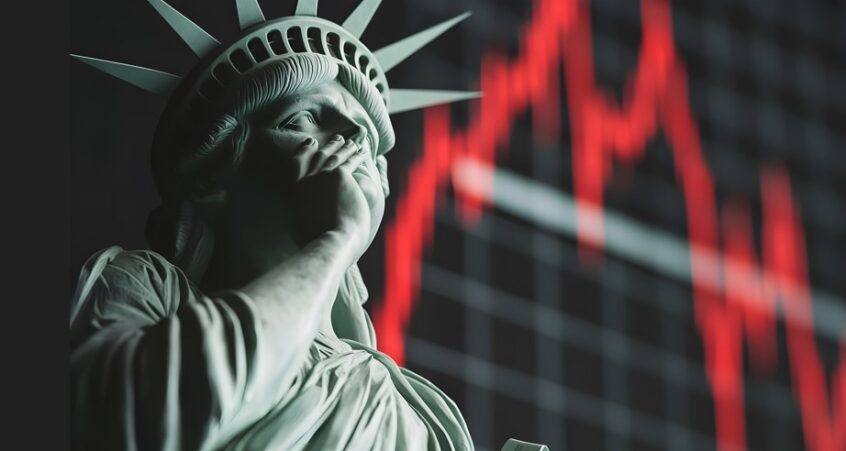Liberation day, far from heralding a new era of US prosperity, has provoked market panic. Global equities lost around 8% in both local currency and sterling terms last week, leaving them down 14% and 15% respectively from their mid-February high. Markets are down a further 2-4% or so today.
Meanwhile, government bonds have provided some protection with US Treasuries and UK gilts both up around 1.5% over the week. Corporate bonds also saw modest gains of 0.5% or so. Gold, however, retreated 1% following its recent surge and the dollar also weakened a bit.
The markets had been viewing Liberation Day with some trepidation but the tariff increases proved considerably larger than expected. A 10% tariff was announced on almost all US imports as a starting point. Then on top of this, ‘reciprocal’ tariffs were announced. Far from being calculated using a complicated formula reflecting other countries’ tariffs, non-trade barriers and tax rates as we had been led to believe, the calculations were unbelievably simplistic.
The tariffs, with a few exceptions such as for Canada and Mexico, simply equate to half the size of a country’s trade deficit in goods with the US as a percentage of the value of its exports to the US. So for the EU, its tariff will be 20% as its trade deficit equates to 39% of the value of its exports. The universal tariff has already been implemented and the reciprocal tariffs start on Wednesday.
These moves should raise the average US tariff by over 20% to 25%, the highest level in over 100 years. So quite how bad is this for the US and global economy? The short answer is that a shallow recession later this year in the US now looks very possible although the extent of the damage wrought remains highly uncertain for several reasons.
First, the scope for countries to negotiate the reciprocal tariffs down is unclear. At least for the moment, the Administration appears intent on playing hard ball and is claiming to be unfazed by the stock market sell-off it has caused. How long this insouciance continues is hard to know but there are already signs of unease within the Republican party which are only likely to grow. The boost to inflation and hit to growth resulting from the tariffs will not go down well with voters – although Trump’s core supporter base may well remain devout come what may.
Second, the scope of the retaliation by other countries will be critical, as will the US response to any such moves. China has already responded with a 34% tariff on US imports, matching one-for-one the 34% reciprocal tariff imposed by the US on top of the existing 20% tariff. The EU intends to retaliate but has yet to announce its plans. As for the UK, it got off lightly as a result of its trade in goods being broadly in balance with the US and is subject to no reciprocal tariff. Still, it continues to face the 10% universal tariff as well as the 25% tariff on autos and steel & aluminium.
The response of other countries, however, will not all be growth negative. As we have already seen, Trump’s policies on tariffs and defence have triggered a major ramp-up of defence and infrastructure spending in Germany and undoubtedly boosted the stimulus measures being put in place in China.
Third, the Fed’s willingness to cut rates later this year, in the face of the conflicting pressures coming from higher inflation but weaker growth, will be crucial. Chair Powell repeated on Friday that the Fed was in no hurry to cut rates. Yet, the markets are now pricing in rates being cut by as much as 1-1.25% by year-end. The Fed has changed policy abruptly in the past and could well do so again later this year if it believes this is needed to head off a recession. Only last September, it cut rates by a bumper 0.5% in response to weak economic numbers.
Fourth, there is the question of how well placed the US economy is to withstand the tariff hikes. Business and consumer confidence have both fallen significantly recently and growth looks set to all but grind to a halt in the first quarter. However, Friday’s payroll numbers for March came in stronger than expected, suggesting the labour market is holding up quite well as yet.
Indeed, US companies and consumers remain in reasonably good shape. While this may not prevent a mild recession later this year, it should prevent a major downturn as these are generally caused by either a sharp rise in interest rates or major imbalances in the economy. Neither is applicable this time.
Given this backdrop, what is the outlook for markets and our advice to investors? Market turbulence looks almost certain to continue over coming weeks and months until the outlook becomes clearer, both in terms of the endgame for tariffs and the amount of damage done to the economy.
The extent of the market decline triggered by a US recession has varied significantly in the past depending on its gravity. But the average decline has been 25%. The US market was down 17% from its high on Friday and following a 2% decline this afternoon, is now down close to 20%.
A considerable amount of bad news is therefore now priced in. While it make take some time for the uncertainty to dissipate and markets to regain their nerve, equities should in time resume their upward trend. As any long-term chart over the last century will testify, even the biggest crises have in time proven to be just a temporary reversal of the powerful underlying upward trend in equities. This time should prove no different.
Still, as our CIO Chris Metcalfe highlighted last week, the investment environment going forward will differ substantially from that prevailing between the global financial crisis and 2020. Globalisation peaked at the start of Covid and has been in decline ever since, with Liberation Day just the latest jolt in this direction. This means there will be new winners and losers going forward and considerable opportunities for investors who can see past the winners of the last few years.
We continue to believe a well-diversified portfolio by both asset class and region remains more crucial than ever. Bonds have proven their worth this year with UK gilts and Treasuries up 2% and 4% respectively year-to-date compared to an 11% fall in equities. Gold even more so with a gain of 12% in sterling terms.
As for equity markets, the losses have been very much concentrated in the US. As of Friday, it was down 16% year-to-date versus a 2% decline in the UK and gains of 2% in Europe and 9% in China. We believe US underperformance is likely to continue and that cheaper markets outside the US have the greatest upside potential when markets do recover.
We believe our investment portfolios are well positioned for current market conditions and no change in positioning is required. Indeed, given the market volatility, making any changes now would just lead to the danger of being whipsawed.

Rupert Thompson – Chief Economist

